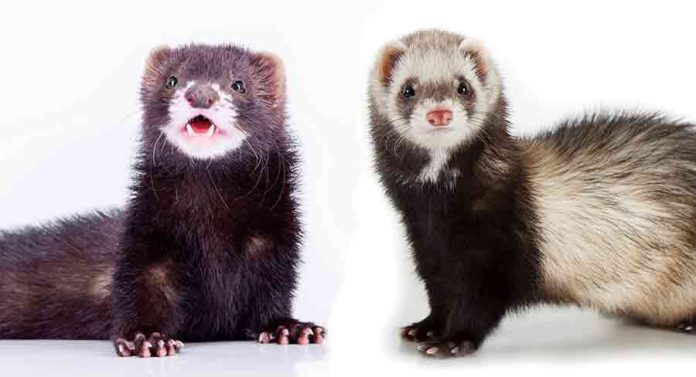Last Updated on February 5, 2024 by Fumipets
The Difference Between Mink vs Ferret
Although the Mink and Ferret have similar appearances, there are some fundamental distinctions between them. The most significant distinction between the two is that the Ferret makes an excellent pet, but the Mink is too wild for a residential environment and needs the care of a zoo or other particular habitat. Another significant distinction is that the Mink is a species, but the Ferret is a subspecies.
Visual Distinction
Mink

Ferret

At a Glance
Mink
• Average height (adult): 12 – 20 inches
• Average weight (adult): 4 – 5 pounds
• Lifespan: 9 – 11 years
• Exercise: 1+ hours a day
• Grooming needs: Moderate
• Family-friendly: No
• Other pet-friendly: No
• Trainability: Nocturnal and solitary
Ferret
• Average height (adult): 18 – 24 inches
• Average weight (adult): 5 – 4. 5 pounds
• Lifespan: 5 – 9 years
• Exercise: 2+ hours a day
• Grooming needs: Moderate
• Family-friendly: Yes
• Other pet-friendly: No
• Trainability: Intelligent, curious, and playful
Mink Overview
The Mink is one of two closely related species of often farmed mammals.

Breeds
Minks are divided into two breeds: European and American. In this part, we’ll look at both.
• American Mink — A semi-aquatic mammal produced in captivity by fur farms, the American Mink is a semi-aquatic animal. Because of careful breeding and diet to generate more fur, it’s a lonely animal that may grow to be double the size of a wild Mink. Mink comes in a variety of hues, such as white, black, blue, sapphire, and pearl.
• European Mink – The European Mink is similar in size to the American variant and is bred in captivity for its fur. European Mink vary from American Mink in that they are less aggressive and flexible. It’s also only available in a dark brown color with white patterns on occasion.
Habitat
As previously stated, the Mink is a semi-aquatic species that may dive as far as 12 feet underwater, necessitating the presence of a small pond. They stick to the seashore, where they will look for food in holes. They devour mice, frogs, salamanders, birds, and eggs and are severe carnivores. Except during mating season, it’s a solitary animal, and the offspring are self-sufficient after just six months.
Suitable for Family
You won’t find many Mink as home pets because of their large surroundings and particular demands, and they’re considerably better off in a zoo where they’ll get expert care. The majority of Mink are reared in captivity at fur farms and spend their whole lives there. They exist only to generate fur for the clothing business.
Ferret Overview
The Ferret is a popular pet in many areas of the globe, and it resembles the Mink but is not the same.

Personality / Character
Ferrets are bright, amiable animals that are naturally interested. It is pleased to explore your house and does not need a habitat with deep water. It can be trained to use a litter box and to do basic tricks.
Health and Care
Ferrets, like skunks, have smell glands that they utilize to mark their territory and will leave a stench in your house. They are, however, exceptionally clean creatures that simply need a wash every now and again. However, these pets are linked to a number of health issues.
Colds and Flu
Ferrets are very sensitive to colds and flu, and they may readily get them from humans. If you’re sick, it’s best to maintain your distance and allow someone else look after them for a few days until you feel better. Watery eyes, sneezing, coughing, weakness, and loose feces are some of the signs to watch for if you suspect your Ferret is sick.
Cardiomyopathy
Cardiomyopathy is a disorder that affects ferrets over the age of three. The heart walls narrow as a result of this condition. The capacity of the heart to pump blood is reduced when the heart walls narrow. Lethargy, weight loss, coughing, and an increased respiratory rate are all symptoms of Cardiomyopathy.
Suitable for Family
Ferrets are excellent family pets and may be kept in any household with adequate room for them to wander about. They’re prohibited in California and Hawaii, and they could be outlawed elsewhere as well, so check with your local authorities to determine whether they’re legal.

Which Breed is Right for You?
When it comes to deciding between a Mink and a Ferret, the Ferret is the only option. The Mink will want more attention and a greater living space than the average person can supply. A ferret is less costly and more suited to live in a house. Their kind and inquisitive attitude will make them a wonderful companion for many years.


















